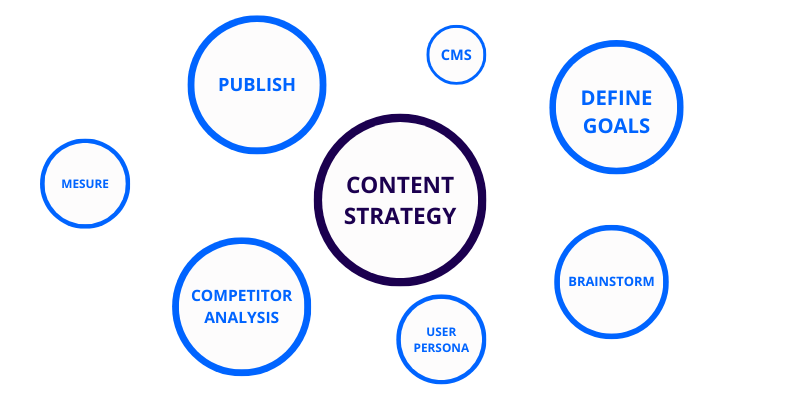A high-quality Content Strategy defines a successful business.
Whether you create content to entertain, inform, or sell, it should always be planned in advance.
This is because it can be helpful to have a documented strategy that shows a bigger picture of how you want your business to grow in the next months or years.
Plus, it will be much easier to organize resources like budgets and teams – which are both critical for a successful content marketing strategy.
What is Content Strategy
Content Strategy is not just throwing random stuff online; it’s a well-thought-out plan covering the planning, creation, publication, management, and governance of content.
Think of it as your roadmap in content marketing to hit your business goals.
It’s all about creating content that grabs your audience’s attention and keeps them hooked.
It should guide them through every step of their journey with you – from just knowing about your solution to becoming your client and even beyond, turning them into loyal customers.
The goal is to create content that’s not only engaging but also aligns perfectly with what your audience needs and pain points.
Why do you need a content strategy?
So, why do you need a content strategy?
- Purpose and Alignment: A content strategy ensures you’re not just creating content for the sake of it. It aligns your content with both your business goals and your audience’s needs. You want to create helpful content for your audience.
- Efficiency: With a strategy, you can map out your content needs for the month, quarter, or year. This helps you allocate your budget and resources smartly.
- Data-Driven Insights: By adopting a content strategy, you get to understand which types of content are best for your audience. It’s not guesswork; it’s about using data to make informed decisions.
- Continuous Improvement: Finally, a content strategy isn’t set in stone. It allows you to evaluate what’s working, what’s not, and how you can improve. It’s a cycle of learning and tweaking, ensuring your content stays fresh and effective.
How to create a successful content strategy in 7 steps:

Here’s your action plan in 7 steps:
- Define your goals;
- Dive into user persona research;
- Research your competition;
- Brainstorm ideas and create a solid content plan;
- Choose a content management system that works for you;
- Publish your content and get it out there;
- Measure the results.
Define your goals:
First thing first: define your business goals.
Ask yourself, why do you want to create content? What’s the big picture here?
It’s crucial to know your business objective for developing a content marketing strategy.
Are you looking to educate people, increase brand awareness, drive sales, or engage with a community?
Here’s a tip: grab a vision board or a notepad and write down your reasons. And be specific.
For instance, you might say, “I want to produce content about sustainable living to educate and inspire people to make eco-friendly choices.”
This step isn’t just about scribbling ideas; it’s about setting a clear direction for your content journey.
Once you decide on your goals, it’ll be much easier to go through the other steps.
Conduct User Persona Research
It’s crucial to understand who your target audience is.
Ask yourself: What do they need? What struggles and pain points are they facing? And, importantly, what are they interested in?
This understanding is key to creating content that’s not just good but useful for them.
First, develop a clear picture of the different types of buyer personas you’re targeting.
Break down their goals, challenges, and doubts.
Ask yourself: Where do they hang out online? Which social media platforms do they use, what blogs do they read, and how do they search for information?
Here is how to do research on your target audience:
- Conduct Research: Dive into user interviews, surveys, and market research. The goal? Get a deep understanding of your target audience’s needs and preferences.
- Segment Audience: Divide them into distinct groups based on their characteristics and behaviors.
- Create Personas: Use the gathered data to develop user personas, which are representations of your ideal users. Include demographic information, needs, and goals.
- Use a Template: To keep things organized, use persona tools or templates.
- Humanize Personas: Give them life! Make these personas relatable with realistic characteristics and stories.
- Refine: Always keep refining your personas based on new feedback and insights.
This approach will not only help you create content that resonates but also ensure it reaches the right target audience.
Research Competition
Conducting market research is key.
Why? It helps you understand what your competitors are doing to attract their audience.
Maybe there’s a strategy they’re using that’s working wonders, or perhaps there’s a gap they’re not addressing that you can capitalize on.
Here’s how to do it: Start by checking out your competitors’ social media channels. Notice the details – how often do they post, what type of content are they using, and how do their followers engage with it?
This can give you insights into what’s working with your shared audience.
If you’re in the SEO field, use SEO Tools to see what keywords your competitors are ranking for and their content quality and analyze their backlink profiles.
This can reveal a lot about their SEO strategy and where they’re getting their traffic from.
Remember, it’s not about copying them.
It’s about understanding their approach and finding ways to do it better or differently.
Keep an eye on what’s working for them, and always think about how you can adapt these insights to fit your unique brand and goals.
Brainstorm Ideas and Create a Content Plan
When it comes to content creation, the first step is brainstorming topics.
What do you want to talk about? Start there.
Then, plan your content production and publishing frequency. How often can you realistically post per week or month? It’s not just about having ideas but also about consistency.
My favorite way to have unlimited content ideas is this:
Pick three main content pillars.
Under each pillar, break them down into six subcategories.
Then, pick these six categories and break each one down into 6 more categories.
And so on.
This breakdown gives you a diverse range of topics under each main theme, ensuring usable content every time you need it.
How often should you publish?
Consider two things:
- The time you can dedicate to content creation;
- What your competitors are doing.
Ideally, you want to match or exceed their frequency but without going crazy.
If it’s too much, think about building a team or asking for help.
Alternatively, you can use AI tools to streamline some processes, making content creation more manageable.
Choose a Content Management System (CMS)
Choosing the right CMS is essential, especially when you’re starting out.
Think of it as your digital organizer, a place where you can track your goals and achievements.
Now, you don’t need anything fancy at the beginning.
A simple Google spreadsheet is more than enough. It’s straightforward, free, accessible, and does the job of keeping your content organized.
However, if you’re already comfortable with management tools, then platforms like Trello are great options.
They offer more features and can help streamline your content planning and execution process.
Create and Publish Content
Your content must be genuinely useful for your readers.
Ask yourself, is this valuable content that solves their problems, answers their questions, or entertains them?
Make sure you create high-quality content by following Google’s E-E-A-T guidelines.
That means it should demonstrate Expertise, Experience, Authoritativeness, and Trustworthiness.
This isn’t just about pleasing search engines; it’s about providing relevant content to your audience and making sure they can rely on your content.
Leverage AI tools to assist you in the content creation process. These tools can be a huge help in streamlining your content creation process, from generating ideas to fine-tuning the final piece.
Just remember that while AI can assist you, the core of your content should always be centered around your audience’s needs and interests.
Mesure Results
Measuring results is crucial in understanding if your content strategy is on the right track.
Here’s the deal: Don’t rush to judge your efforts. Give it a couple of months before you start worrying about results, as it sometimes takes time to see real impact.
How do you keep track?
Use tracking tools like analytics platforms or CRM systems.
These tools will help you monitor how your existing content is performing.
Regularly check the data they provide to spot any gaps in your strategy or areas where you can improve.
Then, use this data to refine your approach.
Are there topics your audience loves? Or ones they don’t engage with?
Implement optimization strategies based on your findings to make your content more effective.
Remember, it’s a continuous process.
Regular analysis and adjustments are key to a successful content strategy.
Frequently Asked Questions
What is an example of content strategy?
An example content strategy for a wellness blog that focuses on informing its users on topics related to health and well-being.
Here’s how you can structure it:
Content Pillars:
- Fitness: Cover topics like workouts, exercise routines, and fitness tips.
- Nutrition: Share healthy recipes, dietary advice, and meal plans.
- Mental Health: Talk about stress management, mindfulness, and self-care practices.
Content Types:
- Blog Posts: Write an in-depth blog post on various wellness topics.
- Videos: Create workout tutorials, cooking demonstrations, and mindfulness sessions.
- Infographics: Design visual content showcasing nutrition facts, exercise routines, etc.
Posting Schedule:
- Aim for consistent postings, like three blog posts per week, a video every two weeks, and a monthly infographic.
Audience Engagement:
- Foster participation through comments, polls, and Q&A sessions.
- Utilize Social Media posts to share blog content, wellness tips, and user-generated content.
SEO Optimization:
- Incorporate relevant keywords for better search engine visibility.
- Regularly update and repurpose your evergreen content.
Collaborations:
- Collaborate with fitness trainers, nutritionists, and mental health experts for guest posts or joint content.
Email Newsletter:
- Send out weekly newsletters featuring content highlights, exclusive content, and benefits for subscribers.
Analytics and Feedback:
- Regularly review website and social media analytics.
- Collect user feedback via surveys to continuously refine and improve your content strategy.
How often should I update my Content Strategy?
When it comes to content strategy, especially in marketing, it’s crucial to revisit and revise your plans regularly.
One effective approach is a quarterly evaluation. Every three months, take a step back and align your marketing plan with your evolving business goals and the ever-changing market dynamics.
Content Strategy vs. Content Marketing Strategy
Content Strategy is like planning the entire roadmap for your online presence.
It involves figuring out what content to create, where to put it, and how to share it.
It’s like drawing a detailed map that helps you create, organize, and spread content to meet what users are looking for and also to help your business.
Now, think of Content Marketing as the way you attract and keep people interested in your online space.
It’s not just about creating content; it’s about making content that’s valuable and interesting for a specific group of people.
The goal here is to get people to take action, like making a purchase, by providing them with useful information and building a connection with your brand.
In simple terms, if Content Strategy is the big plan for your online world, Content Marketing is a specific method within that plan.
It’s the part that focuses on using content to achieve your marketing goals, like attracting more customers.





